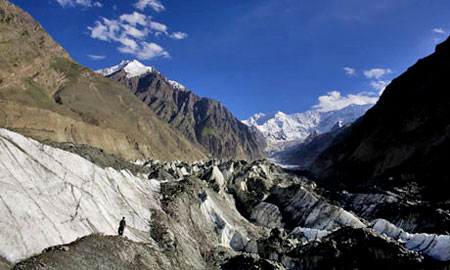|

by Ethan A. Huff
staff writer
February 12, 2012
from
NaturalNews Website
Man-made climate change theory proponents frequently cite claims
that ice caps and glaciers all around the world are melting at an
alarming rate because of excess carbon dioxide (CO2).
But new research published in the
journal Nature reveals that, contrary to popular belief, ice caps in
the Himalayan mountains and many nearby peaks have not actually
melted at all in the past ten years.
Professor John Wahr from the University of Colorado and his
team evaluated data collected by a pair of satellites known as
"Grace" that measured changes in the earth's gravitational pull from
500 kilometers (311 miles) up in space.
These satellites revealed that ice
levels in these high peaks are basically the same as they were a
decade ago, despite the fact that many people still think they are
melting.
"I believe this data is the most
reliable estimate of global glacier mass balance that has been
produced to date," Professor Jonathan Bamber, a glaciologist
from Bristol University in the U.K., is quoted as saying to the
Guardian.
"This is a compelling reason to try
to understand what is happening there better."
The reason why many scientists still
believe that ice caps and glaciers in these higher elevations are
melting has to do with the way data on melting has been collected up
until this point.
Rather than come from satellite imagery
and gravitational analysis, most of the research is based on data
gathered on the ground from just a few glaciers, which fails to take
into account the 200,000-or-so glaciers in existence across the
globe.
At the same time, the researchers claim that lower-level ice melting
is still occurring, and that the new findings do not negate existing
theories on global warming. This declaration, however, appears to be
more of a politically-charged opinion rather than a hypothesis based
on the facts, as there simply is no concrete evidence that ice caps
as a whole are melting any faster than usual, or that man is
responsible for causing this if they are.
The new study is not the only one to blow holes in the sacred cow
theory of man-made global warming, either.
A report published last summer by Human
Events, for instance, revealed that those iconic images of polar
bears dying because of melting ice caps are based on lies.
The polar bears observed in the study
that was used to make this claim appear to have actually died from
an isolated windstorm, which means that polar bears are not
necessarily an endangered species (http://www.naturalnews.com/033370_polar_bars_scientific_fraud.html).
Sources
The Himalayas and Nearby Peaks...
Have Lost No Ice in Past 10 Years
-
Study Shows -
by Damian Carrington
8 February 2012
from
Guardian Website
Meltwater from Asia's peaks is
much less than previously estimated,
but lead scientist says the loss of ice
caps and glaciers
around the world remains a
serious concern

Hopar glacier in
Pakistan.
Melting ice outside
the two largest caps - Greenland and Antarctica
is much less
than previously estimated, the study has found.
Photograph: Paula
Bronstein/Getty Images
The world's greatest snow-capped peaks,
which run in a chain from the Himalayas to Tian Shan on the border
of China and Kyrgyzstan, have lost no ice over the last decade, new
research shows.
The discovery has stunned scientists, who had believed that around
50bn tons of meltwater were being shed each year and not being
replaced by new snowfall.
The study is the first to survey all the world's icecaps and
glaciers and was made possible by the use of satellite data.
Overall, the contribution of melting ice outside the two largest
caps -
Greenland and
Antarctica - is much less than previously
estimated, with the lack of ice loss in the Himalayas and the other
high peaks of Asia responsible for most of the discrepancy.
Bristol University glaciologist Prof Jonathan Bamber, who was
not part of the research team, said:
"The very unexpected result was the
negligible mass loss from high mountain Asia, which is not
significantly different from zero."
The melting of Himalayan glaciers caused
controversy in 2009 when a report from the UN's Intergovernmental
Panel on Climate Change 'mistakenly' stated that they would disappear
by 2035, instead of 2350.
However, the scientist who led the new
work is clear that while greater uncertainty has been discovered in
Asia's highest mountains, the melting of ice caps and glaciers
around the world remains a serious concern.
"Our results and those of everyone
else show we are losing a huge amount of water into the oceans
every year," said Prof John Wahr of the University of Colorado.
"People should be just as worried about the melting of the
world's ice as they were before."
His team's study,
published in the journal Nature,
concludes that between 443-629 bn tonnes of meltwater overall are
added to the world's oceans each year.
This is raising sea level by
about 1.5mm a year, the team reports, in addition to the 2mm a year
caused by
expansion of the warming ocean.
The scientists are careful to point out that lower-altitude glaciers
in the Asian mountain ranges - sometimes dubbed the "third pole" -
are definitely melting. Satellite images and reports confirm this.
But over the study period from 2003-10 enough ice was added to the
peaks to compensate.
The impact on predictions for future sea level rise is yet to be
fully studied but Bamber said:
"The projections for sea level rise
by 2100 will not change by much, say 5cm or so, so we are
talking about a very small modification."
Existing estimates range
from 30cm to
1m.
Wahr warned that while crucial to a better understanding of
ice melting, the eight years of data is a relatively short time
period and that variable monsoons mean year-to-year changes in ice
mass of hundreds of billions of tons.
"It is awfully dangerous to take an
eight-year record and predict even the next eight years, let
alone the next century," he said.
The reason for the radical reappraisal
of ice melting in Asia is the different ways in which the current
and previous studies were conducted.
Until now, estimates of melt-water loss
for all the world's 200,000 glaciers were based on extrapolations of
data from a few hundred monitored on the ground. Those glaciers at
lower altitudes are much easier for scientists to get to and so were
more frequently included, but they were also more prone to melting.
The bias was particularly strong in Asia, said Wahr:
"There extrapolation is really tough
as only a handful of lower-altitude glaciers are monitored and
there are thousands there very high up."
The new study used a
pair of satellites,
called Grace, which measure tiny changes in the Earth's
gravitational pull.
When ice is lost, the gravitational pull weakens
and is detected by the orbiting spacecraft.
"They fly at 500km, so they see
everything," said Wahr, including the hard-to-reach,
high-altitude glaciers.
"I believe this data is the most
reliable estimate of global glacier mass balance that has been
produced to date," said Bamber.
He noted that 1.4 billion people depend
on the rivers that flow from the Himalayas and Tibetan plateau:
"That is a compelling reason to try
to understand what is happening there better."
He added:
"The new data does not mean that
concerns about climate change are overblown in any way. It means
there is a much larger uncertainty in high mountain Asia than we
thought.
Taken globally all the observations of the Earth's ice
- permafrost, Arctic sea ice, snow cover and glaciers - are
going in the same direction."
Grace launched in 2002 and continues to
monitor the planet, but it has passed its expected mission span and
its batteries are beginning to weaken.
A replacement mission has
been approved by the US and German space agencies and could launch
in 2016.
|

